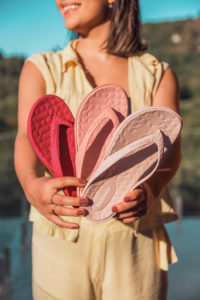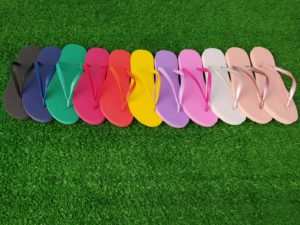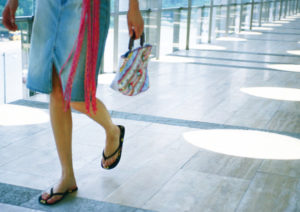Porto Alegre – The innovative Brazilian industry has transformed the functional product into a fashion staple. Men, women, children from all social and cultural spheres wear the traditional flip-flops for walking, shopping, school, and, in some cases, even work. Envisioning all the possibilities, Brazilian footwear manufacturers began investing solidly in flip-flops within their product ranges and turned them into the main export product in the sector. Large, small, and even micro companies diversify their ranges and invest in the product.

Flip-flops account for over half of the international sales of the Brazilian footwear industry. According to data from the Brazilian Association of Footwear Industries (Abicalçados), from January to September this year, the product generated 52.4% of the sector’s shipments in terms of volume, despite accounting for only 18.8% of export revenue due to the lower price in comparison to other models. Over 45 million pairs of flip-flops left Brazilian ports to conquer the world this year, making the country an essential player.
boaonda, a company based in the city of Sapiranga, in the state of Rio Grande do Sul, was established in 2008, with flip-flops being the first product launched, together with the clog, produced in polyurethane, thermoplastic rubber, EVA, and PVC. The brand serves all Brazilian states and exports to over 30 countries. “It has always been the brand’s main product, as we aim to deliver comfort and wellness with a unique design,” said Brand Manager Cássio Romani. Currently producing 5,000 pairs a day, boaonda has around 30 footwear models, more than half of which are flip-flops.
The brand’s consumers are men and women who seek comfortable and well-designed products and value well-being, especially in their moment of rest. According to Romani, boaonda’s consumers value and understand nature’s resources as finite and seek alternatives to contribute to a more sustainable production chain. This way, the brand aims to produce comfort footwear through insoles, engineering, differentiated design, and sustainable production practices.
During the pandemic, boaonda managed to maintain its production. “We had good sales because of the developed product and the space we had already conquered in the market. By combining these factors, we could structure ourselves, obtaining more strength for the brand,” celebrates the manager.
The company serves physical retail and operates in online multi-brand marketplaces, in addition to its e-commerce. By 2022, boaonda intends to extend its growth, conquering market and brand value. “We have an over 10% growth projection for next year,” evaluates Cássio Romani.
A new source of income
Lucapé flip-flop manufacturing, based in the city of Iguaraçu, in the state of Paraná, was founded three years ago as an alternative to complement the family’s income. The company operates in a space that is already starting to become small, according to owner Karen Rayane Ribeiro da Silva Batista, who at the age of 28 decided to quit her formal sales job and open her own business. “We serve the domestic market, but we also sold to Italy and Spain through marketplaces. We produce rubber flip-flops from children’s to adult sizes, with men’s and women’s lines,” she explained.

Before the pandemic, part of the production was dedicated to custom orders for weddings, birthdays, and graduation parties. This segment was discontinued for the time being but could be resumed as soon as the events market upturns. “We serve wholesalers and retailers, as well as embroiderers who buy our flip-flops to be decorated and customized with stones,” she revealed.
Karen is the general manager of the brand and has two more employees; her production is on-demand, but, on average, she produces 150 pairs a day. She notes the company has never run out of orders, and the market for her product has always been booming. “We have plans for growth, which will also mean expanding the space so we can resume the manufacturing of customized products,” plans the owner of Lucapé, a brand whose name is inspired by her son Lucas.
Lucapé offers two lines of flip-flops, the traditional with wide straps, and the slim, with thinner straps. The color chart ranges from black and white through yellow, green, blue, red, pink, and metallic straps. The insoles are also marketed separately. “Our product uses high-quality raw materials, and we have our insole design conceived for the comfort and durability of the flip-flops,” emphasizes the entrepreneur.
Eclectic and comfortable footwear

Journalist and fashion researcher Nelson Batista Zimmer recalls, in Brazil, the most famous production of flip-flops began in the 1960s. It was signed by Alpargatas SA, with the trade name ‘Havaianas.’ Since then, the model has become popular, gained numerous versions and finishes. It became a hit among youngsters in several historical moments, and today it is the most eclectic Brazilian footwear. “One of the symbols of Brazil abroad, known in the main fashion capitals of the world. Its success is also an incredible marketing case, of the transformation of a simple product into a popular and democratic fashion staple.”
Zimmer recalls, “Nothing is more liberating and comfortable than a nice pair of flip-flops. The footwear crossing cultural and economic barriers are at the feet of all social classes and styles, combined with an ample wardrobe. He points out flip-flops also started to communicate over time and evolution through prints and colors, messages, and information of all kinds. “Flags of countries and social movements, cultural characters, color combinations; you can see basically everything in this footwear range that is absolutely at the feet of all beach and pool lovers around the globe.”
Modern designs feature stones and sophisticated details to the straps, elevating their status to genuine gems. “A glamour movement that is drawing the attention of fashionistas around the world,” emphasized the researcher.
In ancient times:
– Egyptians used palm leaves and papyrus as their slippers.
– Indians used to make them in wood with wefts of straw.
– Chinese and Japanese produced their pairs using rice straw.
– The Massai people, originally from Africa, already used rawhide.
In Modern Times:
Flip-flops, or slippers, originated after World War II in the United States. American soldiers who had contact with Japanese culture took into their bags, when they returned home, the zori, a slipper used in that country, which inspired their production with innovative designs, colors, ornaments, and materials. The goal was to offer a comfortable product for all ages and social spheres. Its popularity boomed in the 1960s when it started to be adopted by people looking for a casual style, especially those who visited the Californian beaches.
* Special report by Lisiane Mossmann for ANBA
Translated by Elúsio Brasileiro




